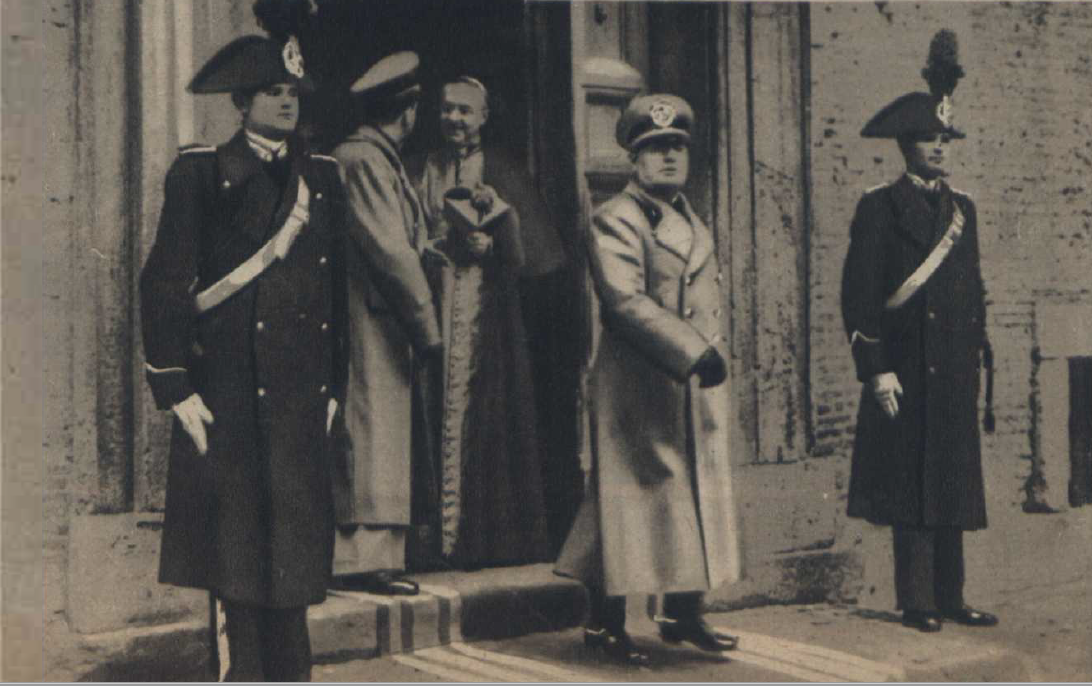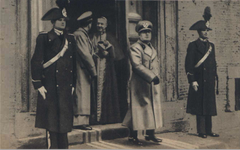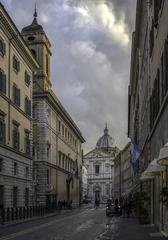
Sant’Andrea della Valle, Rome: Visiting Hours, Tickets, and Historical Sites Guide
Date: 14/06/2025
Introduction
Sant’Andrea della Valle is a resplendent Baroque basilica nestled in the historic heart of Rome. As the mother church of the Theatine Order, it is both a monument to the city’s artistic innovation and a compelling symbol of Catholic devotion during the Counter-Reformation. Its monumental dome—the third largest in Rome—crowns a richly decorated interior filled with masterpieces by Lanfranco, Domenichino, and others. The church has long been a destination for pilgrims, art lovers, and opera enthusiasts, notably serving as the setting for Puccini’s “Tosca.” This comprehensive guide covers Sant’Andrea della Valle’s history, cultural significance, artistic highlights, practical visitor information, and tips for making the most of your visit to this essential Rome historical site.
For further authoritative background, see the Sacred Architecture article and the official website.
Table of Contents
- Introduction
- Historical Overview
- Artistic and Cultural Highlights
- Practical Visitor Information
- Nearby Attractions
- FAQs
- Conclusion
- Resources and External Links
Historical Overview
Origins and Foundation
Founded in 1524 by Gian Pietro Carafa (later Pope Paul IV) and Gaetano dei Conti di Thiene, the Theatine Order established Sant’Andrea della Valle as its mother church. The site was donated by the Della Valle family, and the church is dedicated to Saint Andrew, the patron of Amalfi, reflecting its origins and the order’s mission in urban ministry during the Catholic Reformation (Sacred Architecture).
Construction began in 1603 on the site of the former Palazzo Piccolomini. Initial constraints led to a modest structure, but transformative patronage from Cardinal Montalto (Alessandro Peretti) enabled the demolition of adjacent buildings and the realization of a grander basilica.
Architectural Evolution
Sant’Andrea della Valle’s design draws heavily on the Church of the Gesù, central to Counter-Reformation ideals. Its plan emphasizes acoustics, visibility, and monumental unity. Key architects included Giacomo della Porta (initial design), Carlo Maderno (nave, transept, dome), and Francesco Borromini (lantern) (Sacred Architecture). The dome, completed in 1627, remains one of Rome’s largest and most impressive.
Artistic and Cultural Highlights
The Dome and Vault
The basilica’s dome is the third largest in Rome, rising 16.1 meters in diameter, and its interior is a triumph of Baroque illusionism. Giovanni Lanfranco’s “Celestial Glory” fresco (1625–1627) fills the dome with swirling clouds, angels, and saints, creating a sense of infinite ascent (Sacred Destinations; Wikipedia). The pendentives below the dome feature the four Evangelists by Domenichino, whose classical restraint offers a counterpoint to Lanfranco’s exuberance.
Light streaming through the dome’s windows, along with gold-leafed ornamentation and white travertine pilasters, enhances the church’s sense of grandeur.
Apse and Chapels
The apse is adorned with frescoes narrating the life and martyrdom of Saint Andrew. Domenichino’s scenes in the half-dome and Mattia Preti’s “Crucifixion of Saint Andrew” (1650–1651) are highlights (Sacred Destinations). Sculptural work by Alessandro Algardi and others further enriches the space.
Notable Chapels:
- Chapel of Saint Andrew Avellino: Lanfranco’s “Glory of Sant’Andrea Avellino” and Domenichino’s cupola fresco (Sacred Destinations).
- Chapel of the Crucifix: Antique crucifix, Madonna painting, and tomb of Theatine Cardinal St. Giuseppe Maria Tomasi (Wikipedia).
- Chapel of Our Lady of the Sacred Heart: Designed by Aristide Leonori, features a Madonna by Silverio Capparoni (Wikipedia).
- Rucellai Chapel: Altarpiece by Francesco Manno, walls by Cristoforo Roncalli, and a cupola fresco of music-making angels (Wikipedia).
- Cappella Barberini: Commissioned by Cardinal Maffeo Barberini (later Pope Urban VIII), with paintings by Domenico Cresti and sculptures by Pietro Bernini and Francesco Mochi (Wikipedia).
Tombs and Monuments
Sant’Andrea della Valle shelters the tombs of Popes Pius II and Pius III, the grave of Giovanni della Casa (author of “Il Galateo”), and monuments to notable Roman families, reflecting its role in both papal and artistic history (Sacred Destinations).
Façade and Musical Heritage
The façade, completed by Carlo Rainaldi (1655–1663), is a quintessential Baroque statement of depth and theatricality (Sacred Destinations). The church houses a historic two-manual, 36-stop pipe organ (1845), still used for music and liturgical events (Wikipedia).
Sant’Andrea della Valle in Opera and European Influence
Its association with Puccini’s “Tosca” draws music lovers worldwide (Sacred Destinations). The church’s dome and architectural features influenced churches such as St. Kajetan in Munich and St. Anne in Kraków (Wikipedia).
Practical Visitor Information
Visiting Hours and Admission
- General Opening Hours: Daily, 7:30 a.m. – 7:45 p.m. (The Catholic Traveler)
- Admission: Free; donations are appreciated (TripHobo).
- Mass Times:
- Sundays & Feast Days: 9:00 a.m., 11:00 a.m., 12:00 p.m. (in Filipino), 7:00 p.m.
- Weekdays: 9:00 a.m., 7:00 p.m.
- Confession: Sunday, Tuesday, Thursday, Saturday, 5:30 p.m. – 7:00 p.m. (in English)
- Eucharistic Adoration: Thursdays, from 7:30 p.m.
Check the official website or local listings for updates, especially during holidays and special events.
Getting There and Accessibility
- Address: Piazza Sant’Andrea della Valle, Corso Vittorio Emanuele II, Rome (Touristlink)
- Public Transport:
- Bus: Lines 40, 62, 64
- Metro: Barberini (Line A), 10-minute walk
- Tram: Largo di Torre Argentina, 7-minute walk
- Accessibility: The main entrance is street-level and wheelchair accessible; nave is flat and spacious (Turismo Roma). Contact the church for special assistance.
Facilities and Policies
- Restrooms: No public restrooms inside; nearby cafés typically available for paying customers.
- Photography: Allowed without flash; tripods require permission.
- Dress Code: Modest attire required (shoulders and knees covered).
- Souvenirs: No official gift shop, but religious articles may be available nearby.
- Safety: Watch belongings; be aware of pickpockets outside.
Guided Tours and Special Events
- Guided Tours: Available via local operators (Baroque and religious art-themed tours recommended) (Art & Tradition Tours).
- Concerts: Occasional sacred music events, especially around feast days (Italia.it).
Nearby Attractions
- Piazza Navona: 5–10 minute walk
- Pantheon: 10–15 minutes
- Campo de’ Fiori: 10 minutes
- Palazzo della Cancelleria: nearby
- Dining & Accommodation: Many cafés, trattorias, and hotels in the area (Eitch Borromini)
Frequently Asked Questions (FAQs)
Q: What are the visiting hours?
A: Daily from 7:30 a.m. to 7:45 p.m.
Q: Is there an entrance fee?
A: No, entry is free; donations are welcome.
Q: Are guided tours available?
A: Yes, and highly recommended for a deeper understanding.
Q: Is the church accessible to wheelchair users?
A: Yes, the main entrance is at street level and the nave is flat.
Q: Can I take photographs inside?
A: Yes, non-flash photography is permitted; confirm during Mass or events.
Q: Are restrooms available?
A: No public restrooms inside; use nearby cafés or restaurants.
Conclusion
Sant’Andrea della Valle is a must-see for anyone interested in Rome’s art, history, and spiritual heritage. Its grand dome, celebrated frescoes, and significant role in both religious and cultural history make it a highlight of any visit to the Eternal City. With free admission, generous hours, and central location, it is accessible and rewarding whether you’re a pilgrim, art lover, or traveler. Make the most of your visit by exploring nearby attractions, joining a guided tour, and discovering the stories woven into this Baroque masterpiece.
For up-to-date information, visit the official website and consider downloading the Audiala app for audio tours and insider tips.
Additional Resources and External Links
- Official Sant’Andrea della Valle Website
- Sacred Architecture Article
- Catholic Hierarchy - Sant’Andrea della Valle
- Sacred Destinations
- Wikipedia
- The Catholic Traveler
- Turismo Roma
- Italia.it
- Art & Tradition Tours
- Touristlink
- TripHobo
- Eitch Borromini
Image alt text suggestions:
- “Sant’Andrea della Valle church façade in Rome”
- “Interior dome frescoes of Sant’Andrea della Valle by Giovanni Lanfranco”
- “View of Sant’Andrea della Valle dome dominating Roman skyline”
- “Cappella Strozzi tombs inside Sant’Andrea della Valle”



















































































































































































































































